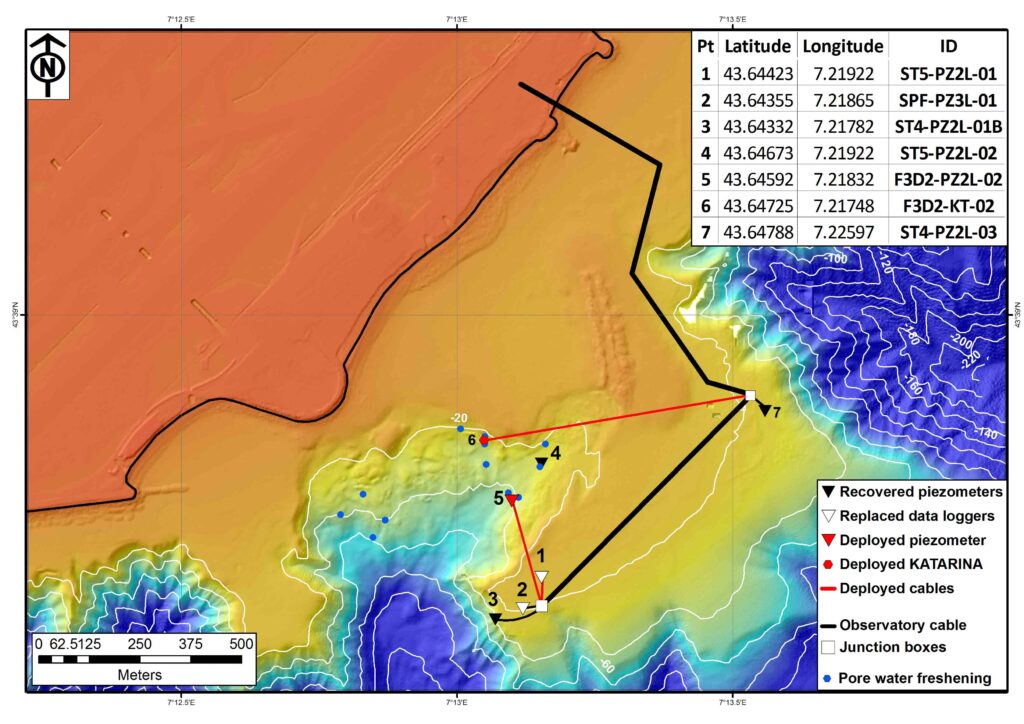The first part of the FLUID3D-2 cruise occurred onboard the R/V l’Europe, off the Nice Airport, in August 20 to 23, 2019. It involved, researchers, engineers and technicians from both IFREMER and MARUM.
 The first objective was to install, at two nearby sites in the failure scar of the 1979 landslide, a seismo-piezometer probe and a seabed station (KATERINA, Figure 1, youtube video ) hosting a radioactivity sensor and a CTD. Priority was given to the installation of these MARUM instruments and to their connection to the EMSO-Ligure-Nice cabled observatory (http://www.emso-fr.org/EMSO-Ligure-Nice/Infrastructure-2017) as part of the Transnational Access service proposed by the EMSO-ERIC through the EMSO-Link project (http://emso.eu/transnational-access/). Unfortunately, because of the presence of hardgrounds, the lance-like seismo-piezometer probe has been damaged. Discussions are ongoing to deploy it again next November during the second part of the FLUID3D-2 cruise. Besides, the KATERINA station has been installed on the seabed and connected to the existing EMSO-Ligure-Nice cabled observatory (Figure 2). Therefore, data relevant to the understanding of the temporal variability of fresh groundwater discharge can now be accessed in real time via the internet.
The first objective was to install, at two nearby sites in the failure scar of the 1979 landslide, a seismo-piezometer probe and a seabed station (KATERINA, Figure 1, youtube video ) hosting a radioactivity sensor and a CTD. Priority was given to the installation of these MARUM instruments and to their connection to the EMSO-Ligure-Nice cabled observatory (http://www.emso-fr.org/EMSO-Ligure-Nice/Infrastructure-2017) as part of the Transnational Access service proposed by the EMSO-ERIC through the EMSO-Link project (http://emso.eu/transnational-access/). Unfortunately, because of the presence of hardgrounds, the lance-like seismo-piezometer probe has been damaged. Discussions are ongoing to deploy it again next November during the second part of the FLUID3D-2 cruise. Besides, the KATERINA station has been installed on the seabed and connected to the existing EMSO-Ligure-Nice cabled observatory (Figure 2). Therefore, data relevant to the understanding of the temporal variability of fresh groundwater discharge can now be accessed in real time via the internet.
The second objective was to recover piezometers which were installed in the sediment since 2013-2015 to measure their pore fluid pressure (Figure 2 youtube video). Real time communication via the EMSO-Ligure-Nice cabled observatory have led to the realisation that two piezometers had to be recovered as they were no more working. The third piezometer recovered was working well autonomously in the failure scar of the 1979 landslide. However, earlier data recovery suggested that it had to be shifted to a site considered as more interesting for the monitoring of pore fluid pressure fluctuations. This was effectively confirmed as this piezometer measurements have not revealed any marked changes over the period 2015-2019. After checking for its integrity, this piezometer was deployed at a site were significant pore pressure fluctuations have been recorded over the period 2007-2009 (see Stegmann et al., 2011). Thereafter divers from IFREMER achieved cable deployments and underwater operations as required to connect this piezometer to the EMSO-Ligure-Nice cabled observatory.
The third objective was to acquire acoustic water column data using both single-beam and multi-beam echo-sounders (SIMRAD EK60 and ME70) with the aim of assessing the spatial distribution and temporal variability of fluids seeps to the water column. This new acoustic survey confirmed that, no matter the season, vigorous fluid flows cross the water column at two sites already identified in 2015 (STEP5 cruise) and 2017 (SEEKLEAK cruise) (Figure 3 youtube video).





